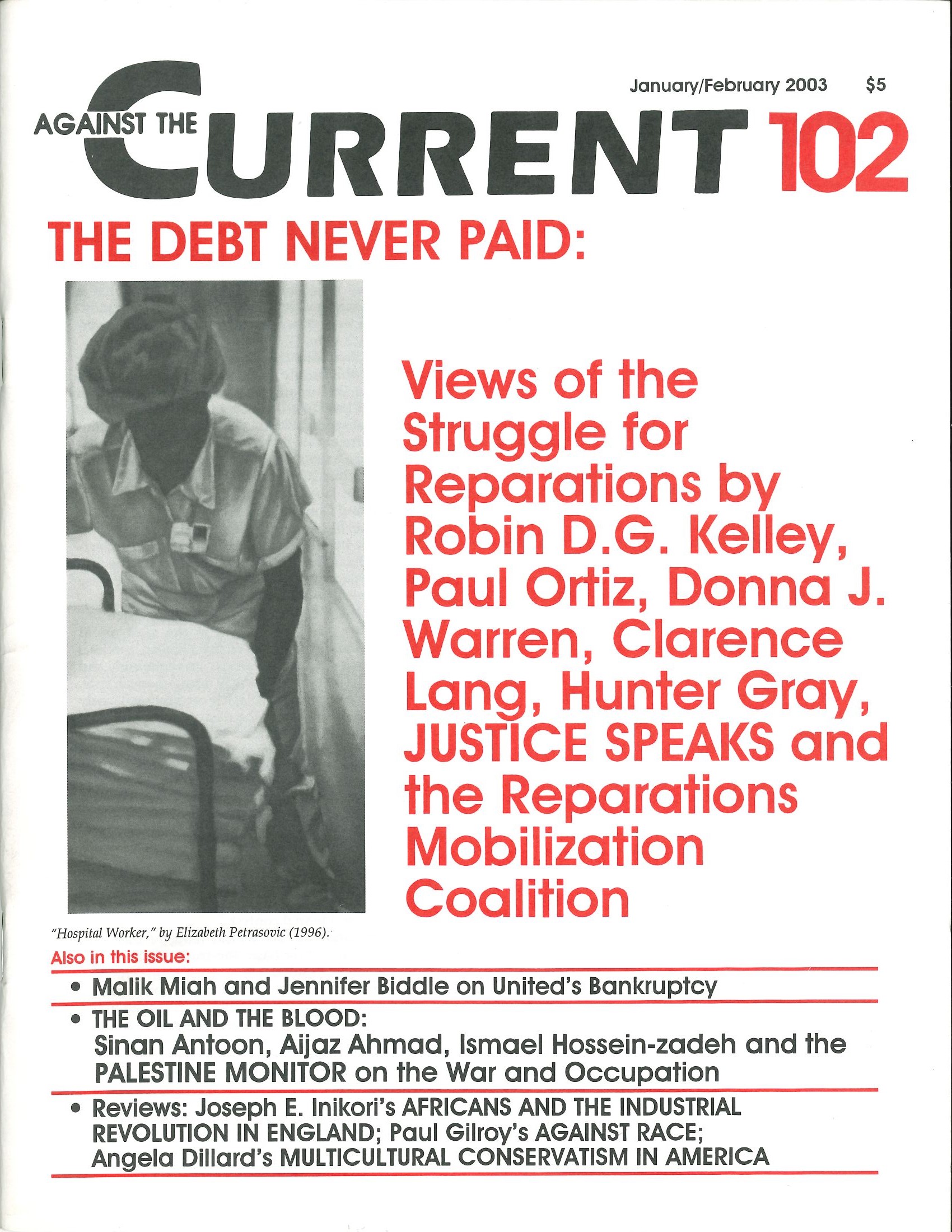Against the Current, No. 102, January/February 2003
-
War and Democrats' Panic
— The Editors -
California Grows Green with Camejo-Warren
— Michael Rubin -
The Rebel Girl: Motherhood's Contested Terrain
— Catherine Sameh -
Random Shots: We Have Met the Enemy
— R.F. Kampfer - Labor Under the Gun
-
United Airlines' Unfriendly Skies
— Malik Miah and Jennifer Biddle -
Mt. Olive: Blood on the Cucumbers
— Nick Wood -
UC Workers Take the CUE
— Claudia Horning and Claudette Begin - Confronting Bush's War
-
The Military-Industrial Empire and War
— Ismael Hossein-zadeh -
The Naivete of A Native Critic
— Sinan Antoon -
On the Invisibility of Blood
— Aijaz Ahmad -
Update: Killing Palestinians with Impunity
— Palestine Monitor - Reparations and the Black Liberation Struggle
-
For Reparations and Transformation
— Robin D.G. Kelley -
The Reparations Demand in History
— Paul Ortiz -
All Out for Millions for Reparations
— Black Workers for Justice -
Launching the Mass Reparations Campaign
— Reparations Mobilization Coalition -
Black Politics, Greens and Reparations
— Donna J. Warren -
Reparations as A New Reconstruction
— Clarence Lang -
A Native American and Civil Rights' View
— Hunter Gray - Speaking Out for Bilingual Education
-
The Battle of "English Only"
— Stephanie Luce -
Those Who Speak Two Languages Live Twice
— Karina Altagracia Bautista - Reviews
-
Abolishing Race in Theory?
— Bill Mullen -
African Labor and England's Industry
— Christopher McAuley -
Multicultural Conservatism
— Christopher Phelps - Letters to Against the Current
-
Two Blunders
— Ernie Haberkern
Stephanie Luce
VOTERS IN TWO states this past November were asked to vote on initiatives to ban bilingual education programs. Modeled after initiatives that passed in California and Arizona a few years earlier, the so-called “English for the Children” proposal, the initiatives would require students to go through a one-year “structured English immersion” program.
Students would be allowed to ask questions in their native language, but would be given English-only materials. After the first year, students would be integrated into regular classrooms and prohibited from speaking in their native language.
Further, teachers could be personally sued if found speaking in other languages in the classroom, and barred from public employment for five years.
Unfortunately, Question 2 passed overwhelmingly (with 68% in favor) in Massachusetts, where fewer than five percent of students are considered to have “limited English proficiency.” In Colorado, however, voters rejected the Amendment 31, with 45.2% in favor and 54.8% opposing.
Bilingual education supporters say that organizing against the Colorado initiative began in 2000, when a similar version was proposed but didn’t make it on the ballot. That effort lay the groundwork for intensive grassroots organizing against this year’s measure. The organizing, along with an increasing Latino vote, handily defeated Amendment 31.
The initiatives in all states have been supported by California millionaire Ronald Unz, who seems to have adopted ending bilingual education as a personal mission. He has spent millions of his own money on the efforts and served as a public spokesperson, hinting at taking his cause to the federal level.
Others behind the initiatives include the Center for Equal Opportunity, a D.C.-based organization devoted to the elimination of bilingual education and affirmative action programs, and another D.C. organization called “U.S. English: Toward a United America,” which was founded by anti-immigrant ideologue Dr. John Tanton.
One of the favored tactics of the anti-bilingual groups is to find immigrants who will serve as spokespeople in favor of English immersion. U.S. English lists its founder as the late Senator S.I. Hayakawa (when some of Tanton’s racist memos became public in 1988, the group formally removed him from leadership).
Sink or Swim
In California, Unz enlisted the efforts of Jaime Escalante (of “Stand and Deliver” fame) to speak against bilingual education. These spokespeople often base their opinions on the fact that they or their parents came to the U.S., had to “sink or swim” to learn English, and did just fine.
Despite such spokespeople, Latino voters in both states solidly rejected the measures: 97% of Latinos in Massachusetts and 85% in Colorado voted “No.”
Although there are plenty of success stories of children learning English through immersion like Hayakawa and Escalante, there are far more cases of those children who dropped out of school or had worse performance because they didn’t have access to bilingual education programs.
Although research shows that many youth can learn conversational English in a year, it takes three to four years on average to become proficient in academic subjects. It is also clear that certain students have advantages in picking up English: Those who are very young, those who live in English-speaking neighborhoods, those who have college-educated parents, and those with access to more resources are likely to learn at a faster pace. Those who are older, poor, or in neighborhoods where few people speak English may never pick up adequate language skills through English-only immersion.
Unfortunately, the media seemed to focus much attention on the voices of immigrants who opposed bilingual education. Seldom heard were the stories of those who had gone through some of the bilingual programs, one of which we present here.
ATC 102, January-February 2003

